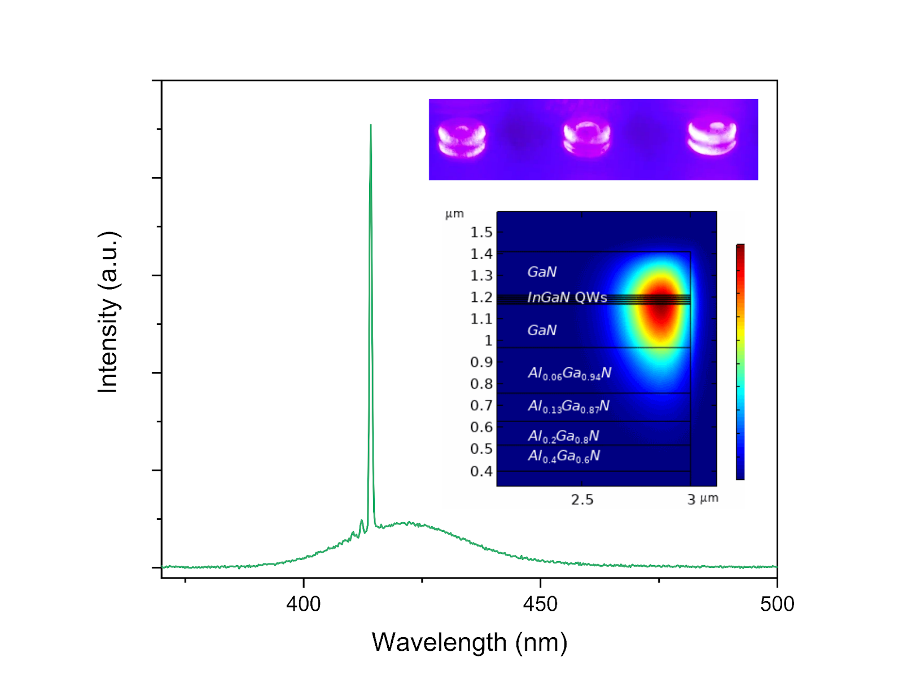Scientists Develop Effective Microlasers as Small as a Speck of Dust

Researchers at HSE University–St Petersburg have discovered a way to create effective microlasers with diameters as small as 5 to 8 micrometres. They operate at room temperature, require no cooling, and can be integrated into microchips. The scientists relied on the whispering gallery effect to trap light and used buffer layers to reduce energy leakage and stress. This approach holds promise for integrating lasers into microchips, sensors, and quantum technologies. The study has been published in Technical Physics Letters.
The devices around us are becoming increasingly compact without sacrificing functionality. Smartphones now handle tasks that once required a computer, and small cameras can capture images with quality approaching that of professional equipment. Miniaturisation has also extended to lasers—sources of directed light that are embedded in optical chips, sensors, medical devices, and communication systems.
However, shrinking a laser while preserving its optical properties, efficiency, and reliability remains a significant challenge. Developing a laser measuring 5–8 micrometres—approximately the diameter of a red blood cell—requires complex calculations, and its fabrication demands high precision. The main challenge lies in the design of the laser itself. Unlike conventional light sources, lasers amplify radiation within a resonator—a structure where light is repeatedly reflected and amplified. The more compact the laser, the harder it is to trap the light inside so that it undergoes continuous reflection and amplification without losing energy, which is essential for stable operation.
Another challenge is the presence of defects in the material. Lasers rely on crystals that can amplify light, but microscopic defects often form during their growth, reducing the efficiency of light generation. To minimise these irregularities, scientists carefully select synthesis conditions and simulate the properties of crystals under various scenarios in advance. However, solving one problem often gives rise to others, turning laser development into a continual search for balance.
HSE scientists have developed microlasers with diameters as small as 5 to 8 micrometres that operate at room temperature. The researchers used a crystal structure composed of indium, gallium, nitrogen, and aluminium compounds grown on a silicon substrate. To trap light in a tiny space, the scientists relied on the whispering gallery effect.

Eduard Moiseev
'This phenomenon is well-known in acoustics: in some churches and cathedrals, you can whisper words against one wall, and the sound will be clearly heard on the opposite wall—even though, under normal conditions, the sound would not travel that far. A similar effect enables light to be repeatedly reflected inside the disk-shaped microlaser, minimising energy loss,' explains Eduard Moiseev, Senior Research Fellow at the International Laboratory of Quantum Optoelectronics, HSE University–St Petersburg.
However, even under these conditions, light waves can partially escape into the substrate and be lost. To prevent this, the researchers added a stepped buffer layer, which compensates for mechanical stresses between the silicon and nitride layers and reduces radiation leakage, enabling the laser to operate stably even at such small sizes.


Natalia Kryzhanovskaya
'Our microlasers operate stably at room temperature without the need for cooling systems, making them convenient for real-world applications. In the future, such devices will enable the creation of more compact and energy-efficient optoelectronic technologies,' explains Natalia Kryzhanovskaya, Head of the International Laboratory of Quantum Optoelectronics at HSE University–St Petersburg.
The paper has been prepared as part of a project implemented within the framework of the International Academic Cooperation competition at HSE University.
See also:
How Colour Affects Pricing: Why Art Collectors Pay More for Blue
Economists from HSE University, St Petersburg State University, and the University of Florida have found which colours in abstract paintings increase their market value. An analysis of thousands of canvases sold at auctions revealed that buyers place a higher value on blue and favour bright, saturated palettes, while showing less appreciation for traditional colour schemes. The article has been published in Information Systems Frontiers.
New Method for Describing Graphene Simplifies Analysis of Nanomaterials
An international team, including scientists from HSE University, has proposed a new mathematical method to analyse the structure of graphene. The scientists demonstrated that the characteristics of a graphene lattice can be represented using a three-step random walk model of a particle. This approach allows the lattice to be described more quickly and without cumbersome calculations. The study has been published in Journal of Physics A: Mathematical and Theoretical.
Scientists Have Modelled Supercapacitor Operation at Molecular and Ionic Level
HSE scientists used supercomputer simulations to study the behaviour of ions and water molecules inside the nanopores of a supercapacitor. The results showed that even a very small amount of water alters the charge distribution inside the nanopores and influences the device’s energy storage capacity. This approach makes it possible to predict how supercapacitors behave under different electrolyte compositions and humidity conditions. The paper has been published in Electrochimica Acta. The study was supported by a grant from the Russian Science Foundation (RSF).
Designing an Accurate Reading Skills Test: Why Parallel Texts are Important in Dyslexia Diagnosis
Researchers from the HSE Centre for Language and Brain have developed a tool for accurately assessing reading skills in adults with reading impairments. It can be used, for instance, before and after sessions with a language therapist. The tool includes two texts that differ in content but are equal in complexity: participants were observed to read them at the same speed, make a similar number of errors, and understand the content to the same degree. Such parallel texts will enable more accurate diagnosis of dyslexia and better monitoring of the effectiveness of interventions aimed at addressing it. The paper has been published in Educational Studies.
HSE University Launches Development of Domestic 6G Communication Technologies Based on Sub-Terahertz Microelectronics
HSE University has launched a large-scale research and engineering initiative to develop domestic technologies for next-generation 6G communication systems. The project is being carried out by the team of the Strategic Technological Project 'Trusted 6G Communication Systems Technology Suite' implemented under the Priority 2030 programme.
Internal Clock: How Heart Rate and Emotions Shape Our Perception of Time
Our perception of time depends on heart rate—this is the conclusion reached by neuroscientists at HSE University. In their experiment, volunteers watched short videos designed to evoke specific emotions and estimated each video's duration, while researchers recorded their heart activity using ECG. The study found that the slower a participant's heart rate, the shorter they perceived the video to be—especially when watching unpleasant content. The study has been published in Frontiers in Psychology.
Scientists Identify Personality Traits That Help Schoolchildren Succeed Academically
Economists from HSE University and the Southern Federal University have found that personality traits such as conscientiousness and open-mindedness help schoolchildren improve their academic performance. The study, conducted across seven countries, was the first large-scale international analysis of the impact of character traits on the academic achievement of 10 and 15-year-olds. The findings have been published in the International Journal of Educational Research.
Intellectual Capital in the Face of Shocks: Russia and Iran Explore Internationalisation
In today's issue of Schola, Mariya Molodchik, Senior Research Fellow at the International Laboratory of Intangible-Driven Economy and Professor at the School of Economics and Finance at HSE University’s Campus in Perm, discusses a joint project with Iran University of Science and Technology, titled 'Internationalization of Companies from Developing Countries: The Role of Intellectual Resources in Response to Exogenous Shocks.'
HSE Researchers Introduce Novel Symmetry-Aware Neural Network Architecture
Researchers at the HSE Laboratory for Geometric Algebra and Applications have developed a new neural network architecture that can accelerate and streamline data analysis in physics, biology, and engineering. The scientists presented their solution on July 16 in Vancouver at ICML 2025, one of the world's leading conferences on machine learning. Both the paper and the source code are publicly available.
Students from HSE and Other Universities Carry Out Research Expedition at New Chersonesos
As part of the Rediscovering Russia student expedition programme, HSE University organised a research trip under the framework of the School for Young Humanities Scholars to the New Chersonesos museum and church complex in Sevastopol. The results of this expedition will form the basis for proposals on educational projects aimed at shaping young people’s historical memory of the role of Chersonesos, Crimea, and the Byzantine legacy in the history of Russian culture and statehood.


